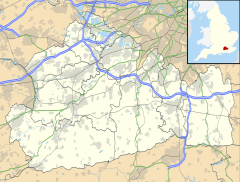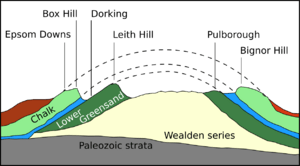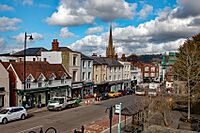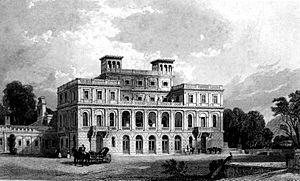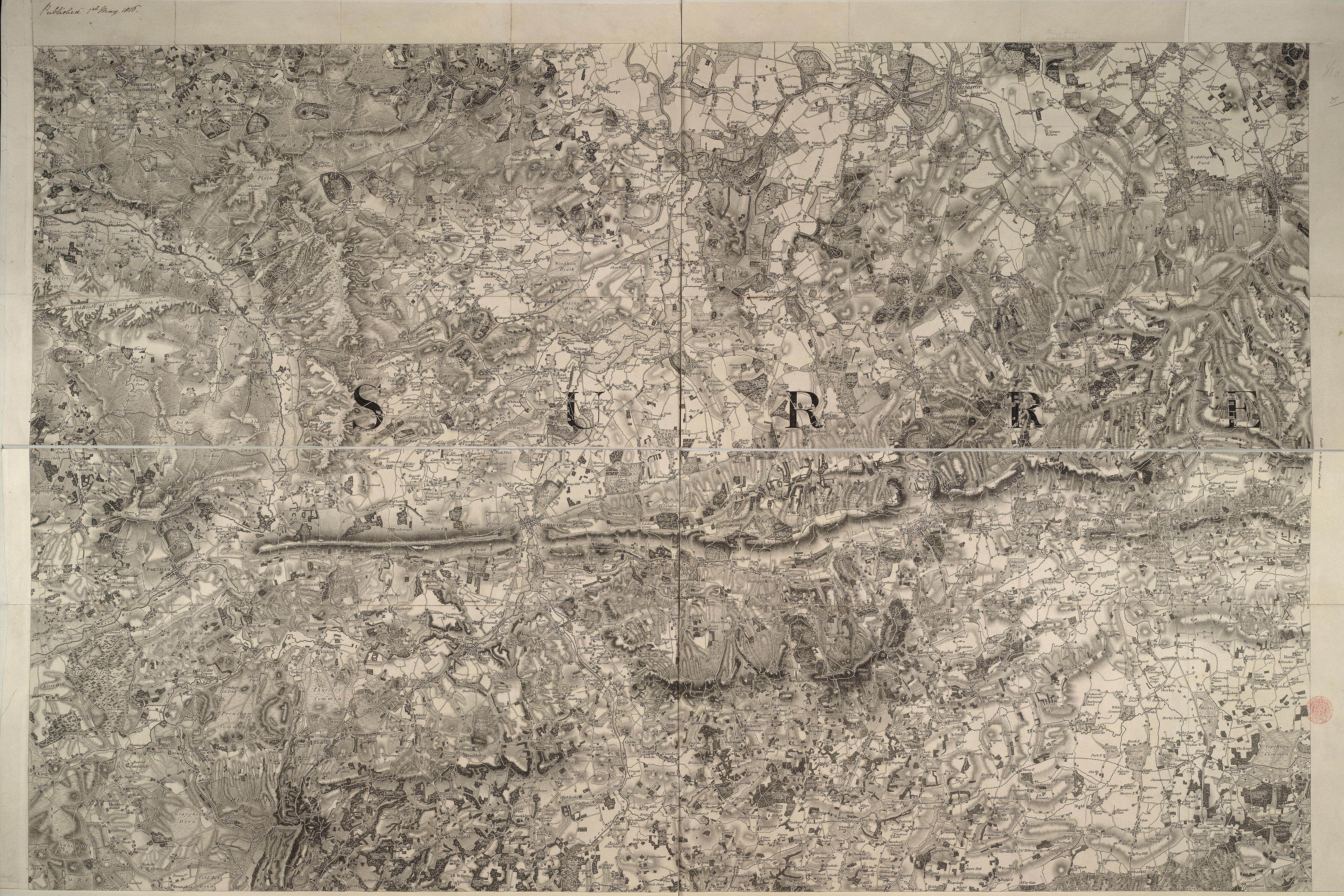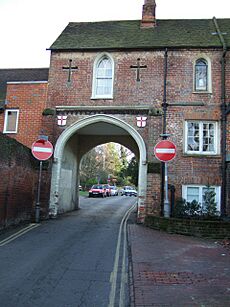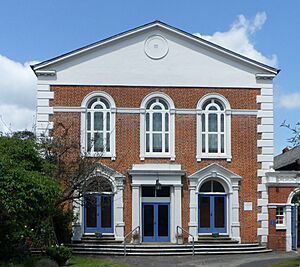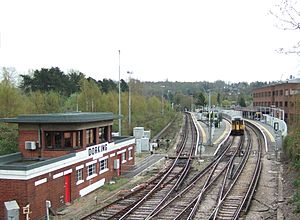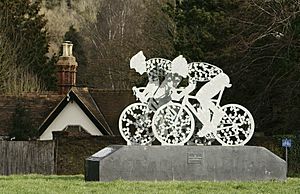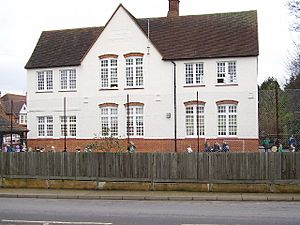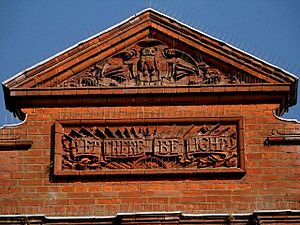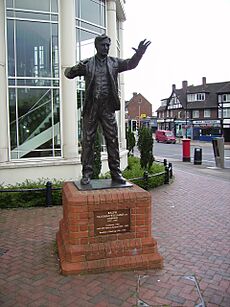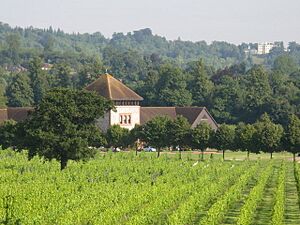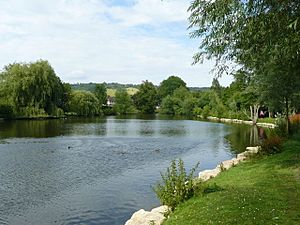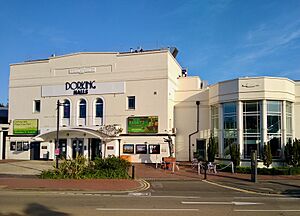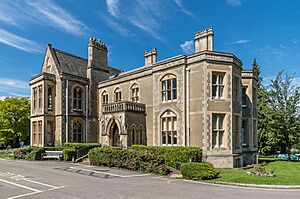Dorking facts for kids
Quick facts for kids Dorking |
|
|---|---|
| Market town | |
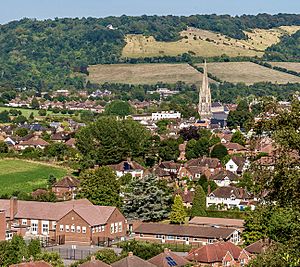 View northeast from The Nower towards Dorking town centre and Box Hill |
|
| Area | 6.57 km2 (2.54 sq mi) town wards |
| Population | 11,158 town wards only 17,098 wider built-up area (2011 census) |
| • Density | 1,698/km2 (4,400/sq mi) |
| OS grid reference | TQ165494 |
| • London | 21 mi (34 km) NNE |
| District |
|
| Shire county | |
| Region | |
| Country | England |
| Sovereign state | United Kingdom |
| Post town | Dorking |
| Postcode district | RH4 |
| Dialling code | 01306 |
| Police | Surrey |
| Fire | Surrey |
| Ambulance | South East Coast |
| EU Parliament | South East England |
| UK Parliament |
|
Dorking is a lively market town in Surrey, England. It's about 34 kilometers (21 miles) south of London. The town is nestled in the beautiful Surrey Hills National Landscape, with famous spots like Box Hill and Leith Hill nearby.
People have lived here for a very long time, since the Mesolithic and Neolithic periods (that's thousands of years ago!). The town might have been a stop on Stane Street, an old Roman road. The name 'Dorking' itself probably comes from Anglo-Saxon times.
Dorking has had a market for centuries, known especially for its poultry. In fact, a special type of domestic chicken called the Dorking chicken is named after the town! Many interesting people have lived here, including six of the Mayflower Pilgrims and the famous author Daniel Defoe.
Over time, Dorking grew as new roads and railways made it easier to travel and trade. Today, it's a popular place to live, surrounded by beautiful countryside.
Contents
What's in a Name?
The exact meaning of the name Dorking is a bit of a mystery! Early spellings include Dorchinges (from 1086). The first part of the name might come from an old personal name, Deorc. Or, it could be from ancient British words like Dorce, meaning "clear stream," or duro, meaning "fort" or "walled town."
Where is Dorking?
Location and Landscape
Dorking is in the middle of Surrey, about 34 kilometers (21 miles) south of London. It sits where two valleys meet: the Mole Gap, where the River Mole cuts through the North Downs, and the Vale of Holmesdale, a low-lying area between the North Downs and the Greensand Ridge.
The highest point in Dorking is the Glory Wood, which is 137 meters (449 feet) high. You can find ancient Bronze Age burial mounds called bowl barrows there.
The town center's layout hasn't changed much since medieval times. The main streets – High Street, West Street, and South Street – meet at a spot called Pump Corner, forming a "Y" shape. The town is surrounded by the Metropolitan Green Belt, which protects its green spaces. Many areas nearby are owned by the National Trust, like Box Hill and Leith Hill Tower.
Rocks and Fossils
The rocks under Dorking are mostly from the Lower Greensand Group. These layers formed in a shallow sea about 100 million years ago. Over millions of years, other layers of rock, including chalk, were laid on top.
Later, the land was pushed up by the same forces that created the Alps! This formed a big dome shape called an anticline. Over time, rivers like the Mole wore away the top of this dome, revealing the different rock layers and creating the hills we see today.
You can find ammonite fossils in the northern part of Dorking. These are spiral-shaped fossils of ancient sea creatures. Smaller Foraminifera fossils have also been found in the Hythe Beds.
Dorking Through Time
Early Days
The oldest signs of people in Dorking are flint tools from the Mesolithic and Neolithic periods. During building work in 2013, burnt hazelnut shells were found, dating back over 10,000 years! They also found a ring ditch with two urns from the Bronze Age.
It's believed there was a settlement here in Roman times. Coins and pottery have been found. The Roman road Stane Street probably ran through Dorking, connecting London to Chichester.
By the time of the Norman Conquest in 1066, Dorking was already a well-known place. In the Domesday Book of 1086, it was listed as the Manor of Dorchinges and was owned by William the Conqueror.
How Dorking Was Governed
For a long time, Dorking was controlled by the "Lord of the Manor," a powerful local noble. Unlike some other towns, Dorking never got a special "Borough Charter" which would have given it more self-rule.
Later, local churches and then special councils took over running the town. In 1881, a "local board of health" was set up to manage things like roads, streetlights, and drainage. They even started the first regular trash collection! In 1972, Dorking joined with Leatherhead to form the Mole Valley District Council.
One important local estate was the Deepdene. It was a large country house with beautiful gardens. Over the years, it was owned by several wealthy families. The main house was even remodeled to look like a grand Italian palace.
Getting Around: Roads and Railways
For a long time after the Romans, transport in Dorking was difficult. Roads were poor, which made it hard for the local economy to grow.
Things changed in 1755 when a new turnpike road was built through Dorking. This made it much easier to get to London. Mail coaches and stagecoaches started using the route daily.
Then came the railway! The first line reached Dorking in 1849. This made it even easier to transport goods like lime (used in building) and brought more wealthy people to live in the town. Over time, more stations were built, and the lines were electrified (meaning trains ran on electricity).
In the 1930s, a bypass road (the A24) was built around Dorking, even though some local people didn't like the idea because it cut through the Deepdene estate.
Trade and Work
Dorking has had a market since at least 1240. It was especially famous for its poultry. The local soil is good for raising chickens, and the Dorking chicken breed is named after the town. People also made wine from wild cherries that grew here.

Chalk and sand were also important industries. Chalk was dug from pits and heated in kilns to make quicklime, which was used to make soil better for farming and later for building in London. silver sand from the area was used to make glass.

Underneath Dorking, there are many caves and tunnels dug into the sandstone. Some were used as cellars for storing wine. Others were dug to find silver sand. One famous cave is the "cockpit" under a former inn, where fighting roosters were once set against each other. You can take guided tours of some of the caves in South Street today!
In the early 1800s, there wasn't enough work for everyone in Dorking. In 1832, a special plan helped 61 young, unemployed people from Dorking move to Upper Canada (now part of Canada) to start new lives.
Growing Town
Even though the turnpike road was built in the 1750s, Dorking didn't change much until the 1800s. Wealthy London businessmen started buying estates here, like Bury Hill and Deepdene. They helped pay for things like paved streets and gas lighting.
Rose Hill was Dorking's first planned neighborhood, started in 1831. The arrival of the railway in 1849 really made the town grow, with many new houses built to the south and west. Later, in the 1920s and 30s, more homes were built to the north and east.
The first council homes were built in Dorking in 1920. In the 1960s, the Goodwyns estate was built, including the 14-story Linden Lea tower block.
Churches and Faiths
The first church in Dorking was mentioned in 1086. Around 1140, a new, larger church was built, which later became St Martin's Church. The current St Martin's Church, with its tall 64-meter (210-foot) spire, was rebuilt in the 1800s.
Many people in Dorking became nonconformists (Protestants who weren't part of the Church of England) after the 1500s. In 1620, six Dorking residents, including William Mullins and his daughter Priscilla, sailed on the Mayflower to America to start a new colony.
Daniel Defoe, the author of Robinson Crusoe, went to school in Dorking around 1669-1674. He attended a non-conformist school. The United Reformed Church in West Street was built for this group in 1834.
John Wesley, who started the Methodist movement, visited Dorking many times in the late 1700s. A Methodist chapel was opened in 1777.
The first Catholic church in Dorking, St Joseph's Church, was built in the 1870s. A mosque was also established in Hart Road in 2006.
Dorking in the World Wars
During World War I, Dorking became a garrison town, meaning soldiers were stationed here. Around 4,000 troops were housed in empty homes. The composer Ralph Vaughan Williams even enlisted in the Royal Army Medical Corps, which had a unit in Dorking.
One of the youngest soldiers from Dorking to die in World War I was Valentine Strudwick. He was born in 1900 and joined the army in 1915, hiding his true age. He was killed in Belgium in 1916, at just 15 years old.
In World War II, Dorking again housed soldiers, and over 3,000 schoolchildren were evacuated to the area. A local committee, led by Vaughan Williams and author E. M. Forster, helped refugees fleeing Nazi persecution.
A strong defensive line was built north of Dorking, with anti-tank obstacles and pillboxes. Although 77 high-explosive bombs were dropped on Dorking by the Luftwaffe, only one incident caused deaths in the town. After the war, two Covenanter tanks were even buried at Bradley Farm; one is now in The Tank Museum.
Getting Around Dorking Today
Roads
The main roads in Dorking are the A24 (London to Worthing) and the A25 (Guildford to Sevenoaks). They meet at Deepdene Roundabout. The town center has a one-way system, which started in 1968.
Railways
Dorking has three railway stations:
- Dorking has trains to London Victoria and London Waterloo.
- Dorking Deepdene and Dorking West have trains to Reading and Gatwick Airport.
Buses
Several bus routes connect Dorking to nearby towns like Guildford, Redhill, Horsham, and Kingston upon Thames.
Cycling and Walking
National Cycle Route 22 goes through Dorking, and the Surrey Cycleway runs to the east. For walkers, the Greensand Way, a long-distance path, passes through the south of Dorking. The North Downs Way is also close by. The Mole Gap Trail starts at Leatherhead and ends at Dorking station.
Learning in Dorking
Primary Schools
Dorking has five primary schools. The oldest is Powell Corderoy School, founded in 1816. St Martin's Primary School started as a National School in the 1830s. St Paul's Primary School opened in 1860.
St Joseph's Catholic Primary School was founded in 1873 by the Duchess of Norfolk and was run by nuns for many years. St John's Primary School was built in 1955 on the Goodwyns housing estate.
Secondary Schools
The Ashcombe School is a coeducational secondary school. It started as separate boys' and girls' high schools in the early 1900s and combined in 1975.
The Priory School opened in 1949 as a secondary modern school. It became a mixed comprehensive school in 1976.
Culture and Arts
Art in Dorking
The Dorking Group of Artists holds art exhibitions twice a year. The Arts Society Dorking helps people learn about and protect the town's artistic heritage.
Leith Hill Musical Festival
The Leith Hill Musical Festival is a big event for local choirs. It takes place every year at the Dorking Halls. The famous composer Ralph Vaughan Williams was the conductor until 1953. Choirs compete in the morning and then perform concerts in the evening.
After Vaughan Williams died, a bronze statue of him was placed outside the Dorking Halls.
Music Studios
Strawberry Studios South opened in Dorking in 1976. Famous musicians like Paul McCartney recorded music there. The English rock band The Cure also recorded at Rhino Studios in Dorking.
Dorking in Books
The Battle of Dorking, a short novel from 1871, was set in the town. It imagined an invasion of Britain by a German-speaking country. Benjamin Disraeli, a former Prime Minister, wrote part of his novel Coningsby while staying at Deepdene.
Sports and Fun
Old Football Game
Years ago, Dorking had a unique football game played every Shrove Tuesday between two teams from the east and west sides of town. It was quite wild! After a very rowdy game in 1897, the local officials stopped the tradition.
Football Today
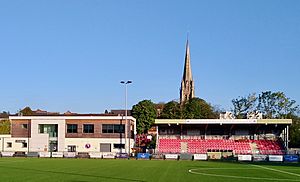
Dorking F.C. was formed in 1880 but closed in 2017. However, Dorking Wanderers F.C. was founded in 1999 and now plays its home games at the refurbished Meadowbank Stadium.
Rugby
Dorking rugby football club started in 1921. They now play at the Big Field in Brockham. Famous players like Elliot Daly and George Kruis have played for Dorking.
Motor Racing
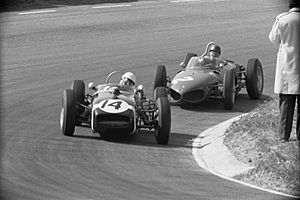
From 1947 to 1970, Rob Walker's private racing team was based in Dorking. Their drivers included the legendary Stirling Moss.
Cycling and Running
Dorking Cycling Club was founded in 1877 and was restarted in 2011. The 2012 Summer Olympic cycling road races even passed through Dorking!
Dorking and Mole Valley Athletics Club hosts the annual Dorking Ten road race. The weekly Mole Valley Parkrun takes place at Denbies Wine Estate, which also hosts the Run Bacchus marathon.
Places to Visit
Denbies Wine Estate
Denbies Wine Estate, north of Dorking, is one of the biggest wine producers in the UK. The vineyard covers about 107 hectares (264 acres). You can visit the winery and visitor center, which opened in 1993.
Dorking Museum
Dorking Museum opened in West Street in 1976. It used to be an iron foundry. The museum has many historical items, fossils, and minerals from the Dorking area. It tells the story of the town from ancient times to today.
South Street Caves
The caves in South Street are a fascinating network of tunnels and caverns dug into the sandstone. Some parts date back to the 1600s! They were used as cellars and to find silver sand. One circular chamber might have been used by religious dissenters. You can take guided tours of these caves, organized by Dorking Museum.
Other Nearby Attractions
Several National Trust properties are close to Dorking, including Box Hill, Leith Hill, Polesden Lacey, and Ranmore Common.
Parks and Green Spaces
Cotmandene
Cotmandene is a large, open common land area east of the town center. In medieval times, people used it to graze pigs. Cricket matches were played here in the 1700s. In 1897, the Lord of the Manor gave Cotmandene to the town, saying it should "remain a perpetual ornament and pleasure."
Deepdene Terrace and Gardens
Deepdene was a country house with beautiful gardens. The gardens were first designed in the 1650s. The grounds include a mausoleum where some of the former owners are buried. The house was taken down in 1969, but the gardens have been restored and are now open to the public as the "Deepdene Trail."
Glory Wood
The Glory Wood is a forest area southeast of Dorking, and it's the highest point in town. It's mostly deciduous trees like oak. The southern part is called "Devil's Den." This wood was given to the town in 1934, with the promise that it would not be built on.
Meadowbank
Meadowbank is a park on the north side of the Pipp Brook. It used to be part of a large estate. The park was landscaped before World War II, and the Pippbrook Mill mill pond was given to the town in 1934. It's now home to Dorking Wanderers F.C..
The Nower
The Nower is an open grassy area west of Dorking. It's a nature reserve where you can enjoy great views of the town from "The Temple," a small building from the early 1800s. The Nower was given to the town in 1931.
Important Buildings and Landmarks
Dorking Cemetery
Dorking Cemetery opened in 1855. It has two chapels, one for Anglicans and one for non-conformists. The famous novelist George Meredith is buried here. The cemetery also has 61 Commonwealth war graves for military personnel from the First and Second World Wars.
Dorking Halls
The Art Deco Dorking Halls building was opened in 1931 for the Leith Hill Musical Festival. It has a large hall for performances and two smaller ones. During World War II, it was used by the Army. Today, it hosts concerts, shows, and has a cinema.
Pippbrook House
Pippbrook House is a Gothic country house built in 1856. It was bought by the Dorking Urban District Council in 1930 for offices. Later, the local public library moved in. There are plans to turn Pippbrook House into a "community hub."
White Horse Hotel
The White Horse Hotel is a very old building. The first record of a building on this site dates back to 1287! It became an inn around 1750. Most of the current hotel was built in the 1700s, but some parts are from the 1400s and 1500s. The famous author Charles Dickens wrote part of his novel The Pickwick Papers while staying here.
Statues and Art

You can't miss the metal sculpture of a Dorking cockerel on the Deepdene roundabout! It was put up in 2007 and is 3 meters (10 feet) tall. It celebrates the town's history with poultry. People often dress it up with hats and scarves!
Outside the Dorking Halls, there are statues of Thomas Cubitt, a master builder, and Ralph Vaughan Williams, the composer. At the Pixham End roundabout, there's a sculpture of two cyclists, unveiled just before the 2012 Olympic road race passed through Dorking.
War Memorial
The town war memorial in South Street was dedicated in 1921 to remember the Dorking men who died in World War I. It was changed in 1945 to also remember those who died in World War II. The names of 264 people, including seven women, are listed on the memorial.
Famous People from Dorking
Three people from Dorking have been awarded the Victoria Cross (VC), the highest military award for bravery:
- Sir William Leslie de la Poer Beresford received his VC for rescuing a comrade in 1879.
- Sir Lewis Halliday was awarded his VC for fighting off an enemy attack in China in 1899.
- Charles Graham Robertson earned his VC for bravely stopping an enemy attack in 1918.
People born in Dorking include:
- Walter Dendy Sadler (1854–1923), an artist.
- Laurence Olivier (1907–1989), a very famous actor and director. You can find a blue plaque marking his birthplace.
- Jamie Mackie (born 1985), a former Scotland international football player.
People who have lived in Dorking include:
- Daniel Defoe (c.1660–1731), the author of Robinson Crusoe.
- The composer Ralph Vaughan Williams (1872–1958) lived in Dorking from 1929 to 1951. His famous work The Lark Ascending was inspired by a poem by George Meredith, who lived nearby.
- Christian O'Connell, a radio DJ, lived in Dorking for several years.
See also
 In Spanish: Dorking para niños
In Spanish: Dorking para niños


